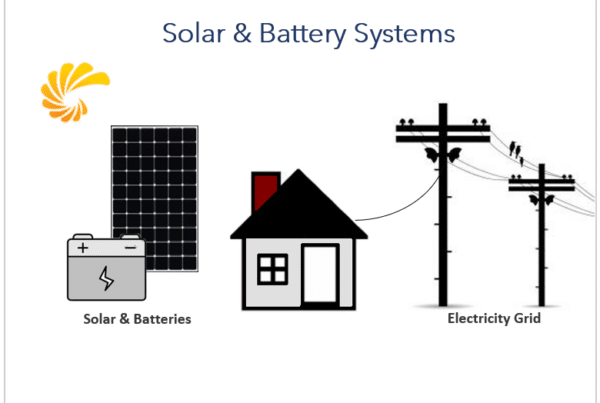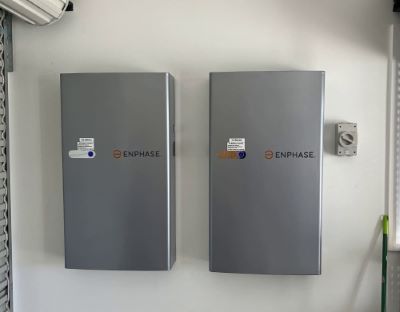Battery Addition
Is it Worth it?
By Bob Hitchens
Why Add A Battery?
The primary premise for battery addition is for the battery to charge up from excess solar energy (prior to being sent to the grid) and to discharge at night to cover potential imported electricity as well as cover days when the solar output is reduced.
This premise is shown in the example below (a consumer that has solar and a battery), the orange lines indicate the consumption pattern for the property, the blue lines indicate the solar output, the black lines indicate the exported energy to the grid, and the green lines the battery activity.
The battery gradually discharges, covering night time consumption until the sun comes up and the solar starts working. The solar energy then charges up the battery after the consumption is covered, and when full, the excess solar energy is exported back to the grid. When the sun goes down, the battery then starts discharging to cover the consumption, and the process is repeated again the next day.

Quantifying The Benefits

To be able to evaluate the ideal battery size, and to do the savings calculation, knowledge of how much solar energy is exported and how much is grid energy is imported is required to get the ideal battery/solar configuration.
If the battery capacity is high enough for any given scenario, the value of not having to import at night is the cost saving achieved. Whatever the quantity of energy required to fill the battery there will be a reduction of an equivalent quantity of exported solar energy that will receive the Feed-in Tariff payment.
The cost of charging the battery is effectively whatever the feed-in tariff is (ie what you receive for the solar energy going back to the grid). The cost saving, i.e. the benefit, is calculated by deducting the FIT from the average imported price charged.
It must be noted, that battery addition will only impact upon the electricity component of the power bill. Daily supply charges will still have to be paid.
The following graph shows the annual benefit gained by a range of differentials between imported electricity prices and the Feed-in Tariff. The greater the level of imports covered, the better the savings.

What Can You Spend On A Battery

Assuming that you have enough solar energy output to meet battery capacity and the capacity is sufficient to cover the imported energy from the grid, an evaluation can be carried out to assess what amount can be justified as an investment in a battery addition.
At a 40c differential, if 17 kWh can be covered, the annual saving is $2,048, which means for a 10-year payback, you could spend up to $20,480 on a battery system. For an 8 year payback, $16,384 could be spent. If 13 kWh is covered, the 10 year payback would be obtained with an expenditure of $15,660 and an 8 year payback of $12,528.
Paybacks in the order of 8-10 years would be considered quite reasonable and good quality battery systems can be purchased in these price ranges.
For systems that only need to cover imported levels less than 13 kWh/day, battery addition is hard to justify, as the payback periods are much longer. Often in these situations, if a battery is added, there is nearly always surplus stored in the battery.
Further financial benefit can be obtained by selling the surplus back into the grid. This is done by signing up to a Virtual Power plant (VPP) such as is offered by the likes of Origin, AGL AMBER etc. The VPP’s available all have slightly different business models in relation to the benefits they generate, and careful evaluation needs to take place before “signing up”.
With VPP’s, surplus energy in the battery is sold back to the grid at a premium, especially in the peak demand periods (generally late afternoon, early evening). The extra income generated by using a VPP can then be used to pay for the supply charge, with the possibility of even generating credit on the bill at certain times of the year.
The VPP inclusion is what then makes payback targets very attractive..
Other Factors That Can Influence The Outcome Of Adding A Battery:

For those looking at the possibility of adding a battery to their existing solar installation there are other factors that will influence the outcome that will need to be considered.
- Payback calculations: are generally made using current pricing data and often don’t take future increases in energy prices into account
- The weather: regional climate patterns have an impact on solar power system output, especially in the winter months.
- Two-way pricing: with the apparent move towards “penalising” excess solar export in the most productive time of the day, and rewarding late afternoon/evening exports, battery addition has a big role to play in minimising the daytime exports (ie by having the potential solar export used to charge the battery).
- Battery compatibility: specifically with the VPP/AMBER scenarios. There is a lot of variation in individual VPP options.
Conclusion:
While the upfront cost of installing a battery can be substantial, the potential savings can make it a worthwhile investment.
At the end of the day, funds will be required for purchase. With the NSW Government battery incentives helping to reduce payback periods and better return on investment (compared to 5 years ago), the use of finance provider options has become more viable.

“At SolarWise Wagga our philosophy is simple, we aim to provide relevant and reliable information, quality service, and the highest grade of products at a competitive price.”
Want More Info?
If you would like more information about solar power and batteries, or would like a consultation & quote, give us a call or enter your details in the enquiry form below.






